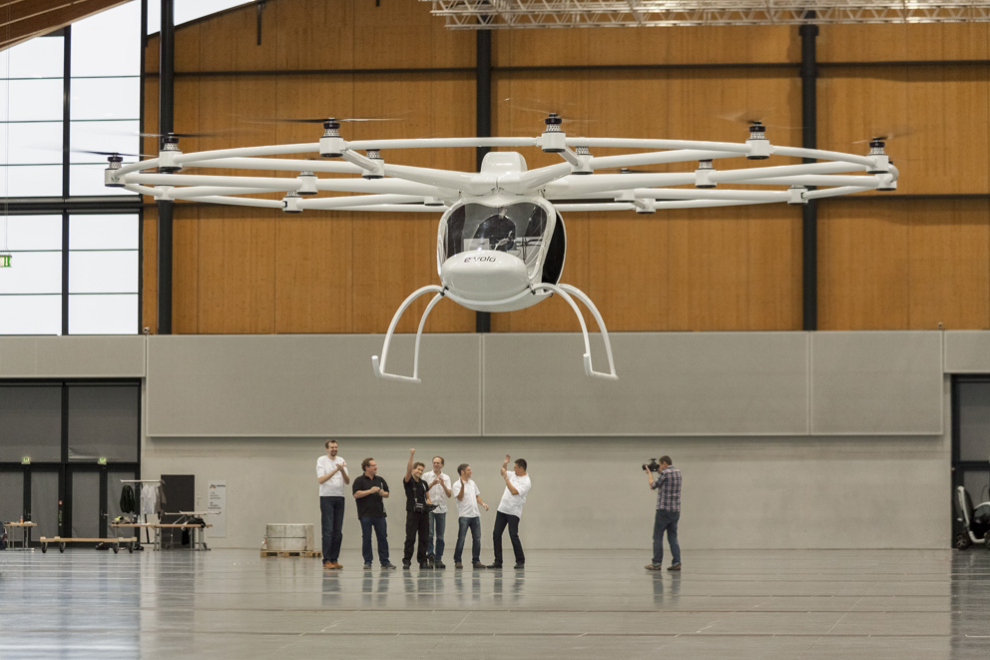E-volo’s Volocopter is a revolution in aviation Made in Germany. Safer, simpler, and cleaner than normal helicopters, it has a unique way of moving – a groundbreaking innovation. The Volocopter is an environmentally friendly and emission-free private helicopter. Instead of one combustion engine, eighteen electrically driven rotors propel it
http://www.suasnews.com/2013/11/26112/successful-maiden-flight-of-the-worlds-first-green-helicopter/

Comments
Josh - Lets compare in this context. Consider first that the battery and the chemical energy contained within it equates to the gas and tank of a conventional powered aircraft and, that the brushless electric motors equate to the turbine, piston or rotor based internal combustion engine. Obviously a flat battery equates to an empty tank, but what does a failed powerplant equate too on the e-volo? Is it loss of enough rotors to the airframe out of balance?
Considering that the e-colo has 18 rotors, it seems likely, even plausible, that you could loose more than a few rotors/motors yet still be afforded the ability to initiate a controlled landing, itself no more frightening or demanding on the pilot than an auto-rotation would be in an equivalently sized conventional rotary winged aircraft.
While replacing a single main rotating mass with 18 smaller rotors might rob you of the ability to build up and store adequate kinetic energy in the blades to effectively cushion an emergency landing, it does build in a great deal of redundancy in other ways (plus, who knows, we might see variable vane rotor blades on the production version).
What would you rather? A twin seater helicopter with a 4 pot boxer ICE spinning a single main rotor via a geared series of belts, commanded by twin fadecs and drawing from a gas tank with reserve... Or a twin seater multirotor with 18 motors, 18 rotors, main and reserve flight batteries and managed by twin next gen FMUs? Considering the number of systems, parts, complex systems, etc that go into making a conventional helicopter fly, I can't see why the e-volo would be any less survivable.
One would assume that anything capable of taking out more than a few rotors, or motors, on the e-volo - such as a dense flock of birds, lightning strike, EMP pulse or (insert other silly suggestion here)... would be just as likely to render most other equivalently sized aircraft unflyable also.
Granted a multirotor is aerodynamically unstable, whereas a conventional aircraft or helicopter is not. However not all FAA approved aircraft are - take the Osprey, Typhoon and F-22 for example, as well as others which have "relaxed static stability" such as the F-16... each of which obviously fly-by-wire, like the e-volo
Oliver - This thing could probably lift a pilot off the ground for a minute or so running on a couple of 100-year-old technology splash-n-spill lead acid batteries (not far off a potato and a lemon)... Question is, what have they planned for the production model.
Gary - Sonex have been doing some solid development on an electric powered recreational aircraft, and the power to weight ratio of their current flight battery might give a comparative indication of what can be expected from the e-volo if simply powered by a battery.
I did some very rough guestimations based on weight allocations for my CF Octocopter project (mini octo that carries a brushless 2-axis gopro at approx 50% thrust with flight time of about 20minutes), making no allowance for the fact that e-volo uses 18 rotors instead of 8, making many broad assumptions and remaining ignorant to how the physics change as the scale increases, I hypothesise the following:
44.44
I haven't the faintest idea how to estimate flight time (wish I knew the blade specs, that would be a big help), and the above numbers probably have no basis in reality. I really think that they have got to be thinking about adding a turbine to it.
Cliff-E - Sorry mate, but you ain't gonna pull any chicks in an X2!
It's a beautiful experiment, it flights noiseless. But do we need a PAV with eighteen props? I think that we have to go through a bicopter/quadcopter with high efficiency and good controllers to simplify the flight.
That's a really, really nice (e.g. clean) indoor arena. I'm sure ground effect played a big part in this experiment and why they were surprised that it hovered well. Then again, I'm sure they were counting on ground effect to actually make it happen, and being indoors just helps immensely.
I'd be interested if they devised a fast enough motor controller (the challenge with heavy lifters), & of course, lots of computer modeling for throttle control, and likely did the 1800's method: make sure everything is balanced to perfection and the motors matched (e.g. a Ladybird, yes, like a QR Ladybird does!).
The efficiency vs battery capacity... again, is the challenge for electric. But for human transport, I'd go with the X2...
I think the question I would ask is just how much ground would I be looking at in forward flight. AscTec are an amazing company with really nice folks working there. Despite what others will say they started the quad revolution really.
Pretty. Can it get its butt off the ground with a pilot on board, and does it come with a really long extension cord or is it powered by a potato and a lemon?
@Josh the USA is not the only country on the planet. That would lift a useful amount of pizza's or tacos.
Hobbyking needs to sell larger counterrotating propellers.
It has an emergency parachute which deploys in the event of a total system failure. I guess it uses that in place of autorotation.
What's the point? Aircraft that cannot land without power can't get FAA approval.
And all this for only 2 million euros in grants. The big companies had not even started for that money
-
1
-
2
-
3
of 3 Next